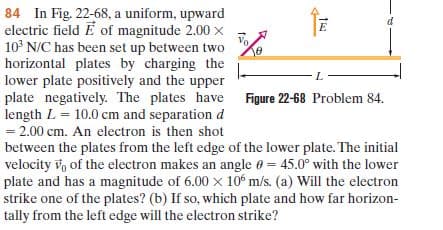84 In Fig. 22-68, a uniform, upward electric field E of magnitude 2.00 x 10° N/C has been set up between two horizontal plates by charging the lower plate positively and the upper plate negatively. The plates have Figure 22-68 Problem 84. length L = 10.0 cm and separation d = 2.00 cm. An electron is then shot between the plates from the left edge of the lower plate. The initial velocity vo of the electron makes an angle e = 45.0° with the lower plate and has a magnitude of 6.00 x 10° m/s. (a) Will the electron strike one of the plates? (b) If so, which plate and how far horizon- tally from the left edge will the electron strike? 7. 1:0
84 In Fig. 22-68, a uniform, upward electric field E of magnitude 2.00 x 10° N/C has been set up between two horizontal plates by charging the lower plate positively and the upper plate negatively. The plates have Figure 22-68 Problem 84. length L = 10.0 cm and separation d = 2.00 cm. An electron is then shot between the plates from the left edge of the lower plate. The initial velocity vo of the electron makes an angle e = 45.0° with the lower plate and has a magnitude of 6.00 x 10° m/s. (a) Will the electron strike one of the plates? (b) If so, which plate and how far horizon- tally from the left edge will the electron strike? 7. 1:0
Principles of Physics: A Calculus-Based Text
5th Edition
ISBN:9781133104261
Author:Raymond A. Serway, John W. Jewett
Publisher:Raymond A. Serway, John W. Jewett
Chapter19: Electric Forces And Electric Fields
Section: Chapter Questions
Problem 76P
Related questions
Question

Transcribed Image Text:84 In Fig. 22-68, a uniform, upward
electric field E of magnitude 2.00 x
10° N/C has been set up between two
horizontal plates by charging the
lower plate positively and the upper
plate negatively. The plates have Figure 22-68 Problem 84.
length L = 10.0 cm and separation d
= 2.00 cm. An electron is then shot
between the plates from the left edge of the lower plate. The initial
velocity vo of the electron makes an angle e = 45.0° with the lower
plate and has a magnitude of 6.00 x 10° m/s. (a) Will the electron
strike one of the plates? (b) If so, which plate and how far horizon-
tally from the left edge will the electron strike?
7.
1:0
Expert Solution
This question has been solved!
Explore an expertly crafted, step-by-step solution for a thorough understanding of key concepts.
This is a popular solution!
Trending now
This is a popular solution!
Step by step
Solved in 5 steps with 5 images

Recommended textbooks for you

Principles of Physics: A Calculus-Based Text
Physics
ISBN:
9781133104261
Author:
Raymond A. Serway, John W. Jewett
Publisher:
Cengage Learning

Physics for Scientists and Engineers, Technology …
Physics
ISBN:
9781305116399
Author:
Raymond A. Serway, John W. Jewett
Publisher:
Cengage Learning

Physics for Scientists and Engineers: Foundations…
Physics
ISBN:
9781133939146
Author:
Katz, Debora M.
Publisher:
Cengage Learning

Principles of Physics: A Calculus-Based Text
Physics
ISBN:
9781133104261
Author:
Raymond A. Serway, John W. Jewett
Publisher:
Cengage Learning

Physics for Scientists and Engineers, Technology …
Physics
ISBN:
9781305116399
Author:
Raymond A. Serway, John W. Jewett
Publisher:
Cengage Learning

Physics for Scientists and Engineers: Foundations…
Physics
ISBN:
9781133939146
Author:
Katz, Debora M.
Publisher:
Cengage Learning

College Physics
Physics
ISBN:
9781305952300
Author:
Raymond A. Serway, Chris Vuille
Publisher:
Cengage Learning

College Physics
Physics
ISBN:
9781285737027
Author:
Raymond A. Serway, Chris Vuille
Publisher:
Cengage Learning